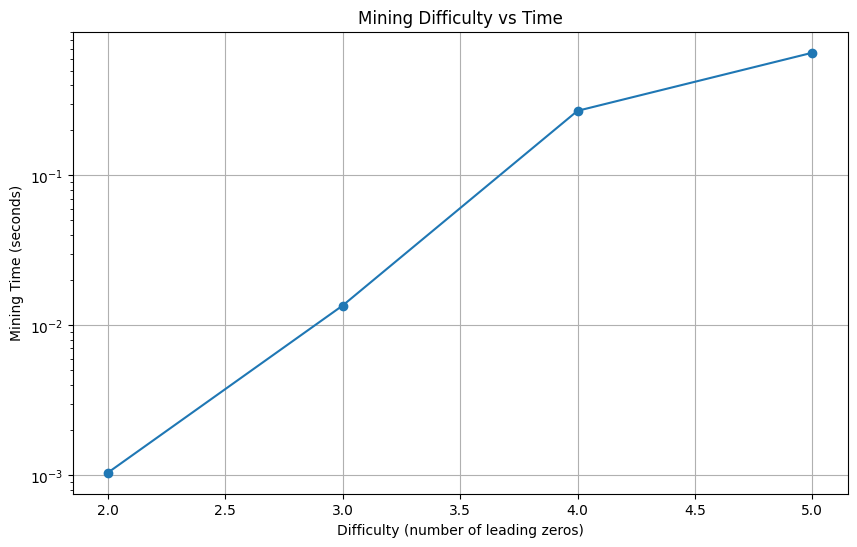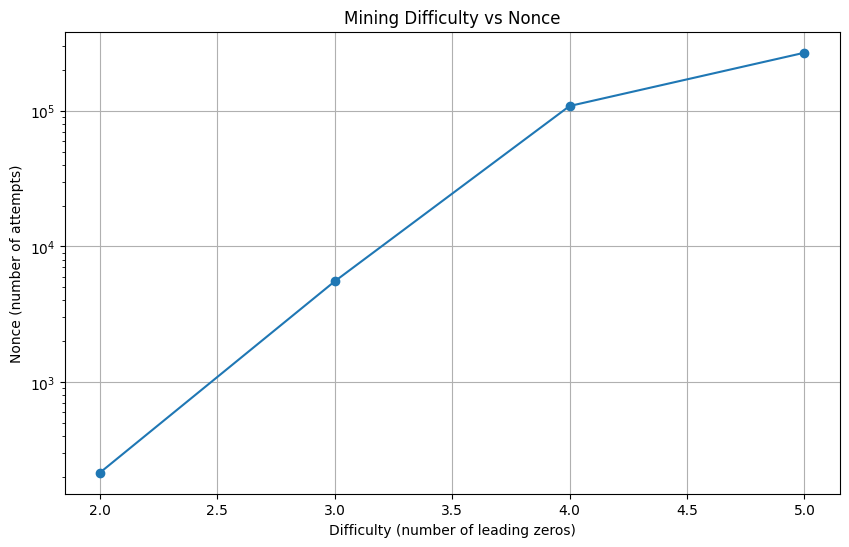Bitcoin Mining: The Heart of the Blockchain#
What is Mining?#
Imagine a global contest where participants solve complex puzzles. The first to solve gets a prize and the right to add a new page to a special book. This is Bitcoin mining in a nutshell!
Miners are the contestants
The puzzle is a cryptographic challenge
The prize is newly created bitcoins and transaction fees
The book is the blockchain
The Mining Process#
Collect unconfirmed transactions: Miners gather recent Bitcoin transactions that haven’t been recorded in the blockchain yet.
Create a block: Miners bundle these transactions into a “block” - like filling a page in our book.
Solve the puzzle: Miners compete to find a special number (nonce) that, when combined with the block data, produces a hash starting with a certain number of zeros.
Seal the block: The winning miner adds their block to the blockchain and receives the mining reward.
Let’s see how this works in code:
Understanding the Mining Process in Code#
Our code will simulate a simplified version of Bitcoin mining. Here’s what it will demonstrate:
How a block is created and its hash is calculated
The mining process of finding a valid hash
How increasing difficulty affects mining time and attempts
Let’s break it down:
import hashlib
import time
import matplotlib.pyplot as plt
class Block:
def __init__(self, transactions, previous_hash):
self.transactions = transactions
self.previous_hash = previous_hash
self.nonce = 0
self.timestamp = time.time()
self.hash = self.calculate_hash()
def calculate_hash(self):
block_content = f"{self.previous_hash}{self.timestamp}{self.nonce}{''.join(self.transactions)}"
return hashlib.sha256(block_content.encode()).hexdigest()
class Blockchain:
def __init__(self):
self.chain = [self.create_genesis_block()]
self.difficulty = 4
self.pending_transactions = []
self.mining_reward = 6.25 # Bitcoin reward as of 2023
def create_genesis_block(self):
return Block(["Genesis Block"], "0" * 64)
def get_latest_block(self):
return self.chain[-1]
def mine_block(self, miner_address):
start_time = time.time()
block = Block(self.pending_transactions, self.get_latest_block().hash)
print("Mining in progress...")
while block.hash[:self.difficulty] != "0" * self.difficulty:
block.nonce += 1
block.hash = block.calculate_hash()
end_time = time.time()
mining_time = end_time - start_time
print(f"Block mined! Time taken: {mining_time:.2f} seconds")
print(f"Block hash: {block.hash}")
print(f"Nonce: {block.nonce}")
self.chain.append(block)
self.pending_transactions = [f"Mining Reward: {self.mining_reward} BTC to {miner_address}"]
return mining_time, block.nonce
Key Parts of the Code Explained#
Block Class: Represents a single block in the blockchain.
calculate_hash(): Creates a unique identifier for the block using its contents.
Blockchain Class: Manages the entire chain of blocks.
mine_block(): Simulates the mining process, trying different nonces until a valid hash is found.
Difficulty: Represented by the number of leading zeros required in the block hash.
Higher difficulty means more zeros, making it harder to find a valid hash.
Nonce: A number that miners change to get different hashes until they find one that meets the difficulty requirement.
This simplified model helps us understand the core concepts of Bitcoin mining without getting lost in the complexities of the actual Bitcoin protocol.
Visualizing Mining Difficulty#
Now, let’s see how changing the mining difficulty affects the mining process. We’ll mine blocks at different difficulty levels and plot the results.
blockchain = Blockchain()
# Add some transactions
blockchain.pending_transactions = [
"Alice sends 1 BTC to Bob",
"Charlie sends 0.5 BTC to David"
]
# Mine blocks with increasing difficulty
difficulties = [2, 3, 4, 5]
mining_times = []
nonces = []
for diff in difficulties:
blockchain.difficulty = diff
time_taken, nonce = blockchain.mine_block("miner_address")
mining_times.append(time_taken)
nonces.append(nonce)
# Visualize the results
plt.figure(figsize=(10, 6))
plt.plot(difficulties, mining_times, marker='o')
plt.title("Mining Difficulty vs Time")
plt.xlabel("Difficulty (number of leading zeros)")
plt.ylabel("Mining Time (seconds)")
plt.yscale('log')
plt.grid(True)
plt.show()
plt.figure(figsize=(10, 6))
plt.plot(difficulties, nonces, marker='o')
plt.title("Mining Difficulty vs Nonce")
plt.xlabel("Difficulty (number of leading zeros)")
plt.ylabel("Nonce (number of attempts)")
plt.yscale('log')
plt.grid(True)
plt.show()
Mining in progress...
Block mined! Time taken: 0.00 seconds
Block hash: 0003acda686418a2a287be70ef03997c2a0cc8c5a047c7fafcb696e46886ce8d
Nonce: 215
Mining in progress...
Block mined! Time taken: 0.01 seconds
Block hash: 00070dad52d361f148608cf0925fdd5624374657c446448500fdb66c4550604c
Nonce: 5533
Mining in progress...
Block mined! Time taken: 0.27 seconds
Block hash: 000054e6ab506cf271a1f6326564c05f8e0c387ba6cd5f23c2b9f03c9981352c
Nonce: 108425
Mining in progress...
Block mined! Time taken: 0.66 seconds
Block hash: 00000023e6fdc483fc5519bc180ec7eeb9159aa7b5101e633ff3706faa7d4b54
Nonce: 267881


Understanding the Graphs#
Mining Difficulty vs Time Graph:
X-axis: Difficulty (number of leading zeros required)
Y-axis: Time taken to mine a block (in seconds)
What it shows: As difficulty increases, mining time grows exponentially
Why it’s important: Demonstrates how Bitcoin can adjust difficulty to maintain consistent block times
Mining Difficulty vs Nonce Graph:
X-axis: Difficulty (number of leading zeros required)
Y-axis: Nonce (number of attempts to find a valid hash)
What it shows: Higher difficulty requires exponentially more attempts to find a valid hash
Why it’s important: Illustrates the increasing computational work required as Bitcoin’s network grows
These visualizations help us understand why mining becomes more challenging over time and how it relates to the security of the Bitcoin network.
Anatomy of a Bitcoin Block#
A Bitcoin block is like a digital container that holds important information. Here’s a detailed look at its structure:
┌──────────────────────────────────────────────────────────┐ │ Block Header │ ├──────────────────────────────────────────────────────────┤ │ Version: 0x20000000 │ │ Previous Block Hash: 0000000000000000000769b… │ │ Merkle Root: 4a5e1e4b… │ │ Timestamp: 2023-10-16 12:34:56 │ │ Difficulty Target: 0x1b0404cb │ │ Nonce: 2083236893 │ ├──────────────────────────────────────────────────────────┤ │ Transactions │ ├──────────────────────────────────────────────────────────┤ │ Transaction 1: Alice sends 1 BTC to Bob │ │ Transaction 2: Charlie sends 0.5 BTC to David │ │ Transaction 3: Eve sends 0.2 BTC to Frank │ │ … │ └──────────────────────────────────────────────────────────┘
Key Components:#
Block Header: Contains metadata about the block, crucial for mining.
Version: Indicates the software version used to create the block.
Previous Block Hash: Links to the previous block, ensuring continuity.
Merkle Root: A single hash summarizing all transactions in the block.
Timestamp: When the block was created.
Difficulty Target: The current difficulty level for mining.
Nonce: A number miners change to find a valid hash.
Transactions: The list of all Bitcoin transactions included in the block.
This visualization helps illustrate how each block is structured and how it connects to the rest of the blockchain. The block header is essential for the mining process, as miners must find a nonce that results in a hash meeting the difficulty target.
Key Concepts:#
Hash Function: A mathematical function that turns any input into a fixed-size string of characters. In Bitcoin, SHA-256 is used.
Nonce: The “number used once” that miners change to get different hashes until they find one meeting the difficulty requirement.
Proof of Work: The solution to the mining puzzle, proving computational work was done.
Block Reward: New bitcoins created and given to the miner who successfully mines a block. It halves approximately every four years.
Mining Pools: Groups of miners who combine their computing power and share rewards, increasing their chances of solving blocks.
Understanding mining helps us see how Bitcoin maintains security and integrity without central authority, using math and incentives to create a trustworthy digital currency system.
What Did We Learn?#
Mining is a competitive process: Miners worldwide race to solve a mathematical puzzle. The winner gets to add a new block and receive a reward.
The puzzle difficulty is adjustable: In Bitcoin, difficulty is measured by the required number of leading zeros in the block hash. More zeros = harder puzzle.
Harder puzzles take longer to solve: As seen in our graphs, increasing difficulty (more leading zeros) dramatically increases solving time and attempts (nonce).
Bitcoin auto-adjusts difficulty: Imagine a race always taking 10 minutes, regardless of runner speed. If faster runners join, the track lengthens. If runners leave, it shortens. This is how Bitcoin maintains its 10-minute average block time as miners join or leave.
Mining secures the network: The difficulty and cost of mining make altering past transactions extremely challenging. It’s like trying to redo all puzzles faster than the entire world combined!
Energy intensive: Mining requires significant computing power and electricity, contributing to Bitcoin’s notable energy consumption.
Quick Check: Did You Get It?#
Let’s see if you caught the main ideas about mining:
What is the primary purpose of mining in Bitcoin? (Hint: It involves solving a puzzle)
What do we call the number that miners change to find a valid hash? (Hint: It’s a “number used once”)
What happens to the mining difficulty as more miners join the network? (Hint: It adjusts to keep block time steady)
What is the reward given to miners for successfully mining a block? (Hint: It’s a type of digital currency)
Think about your answers, then check below!
Click to see the answers
To validate transactions and add new blocks to the blockchain.
Nonce.
The difficulty increases.
Newly created bitcoins (block reward).
Congratulations on completing the mining chapter!
